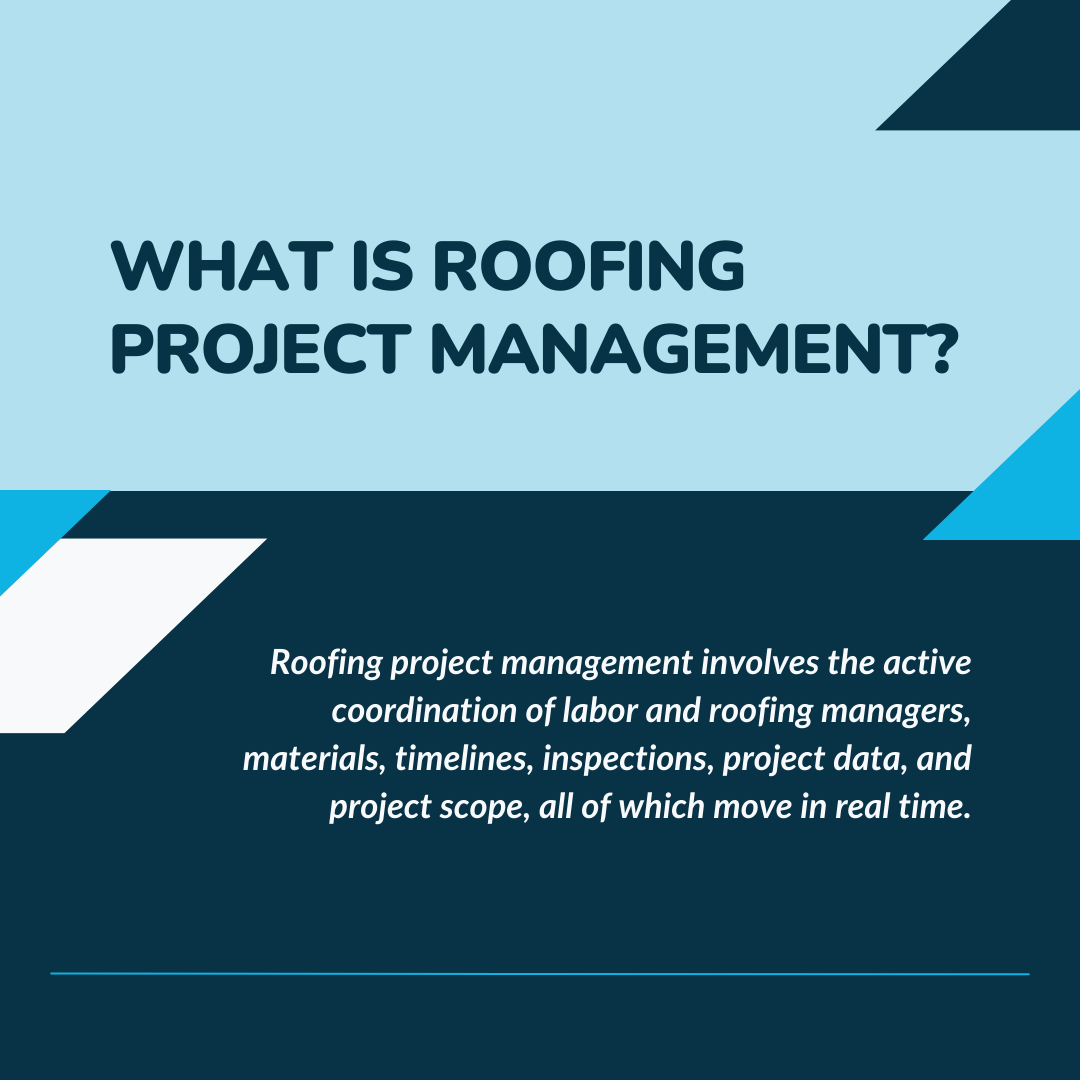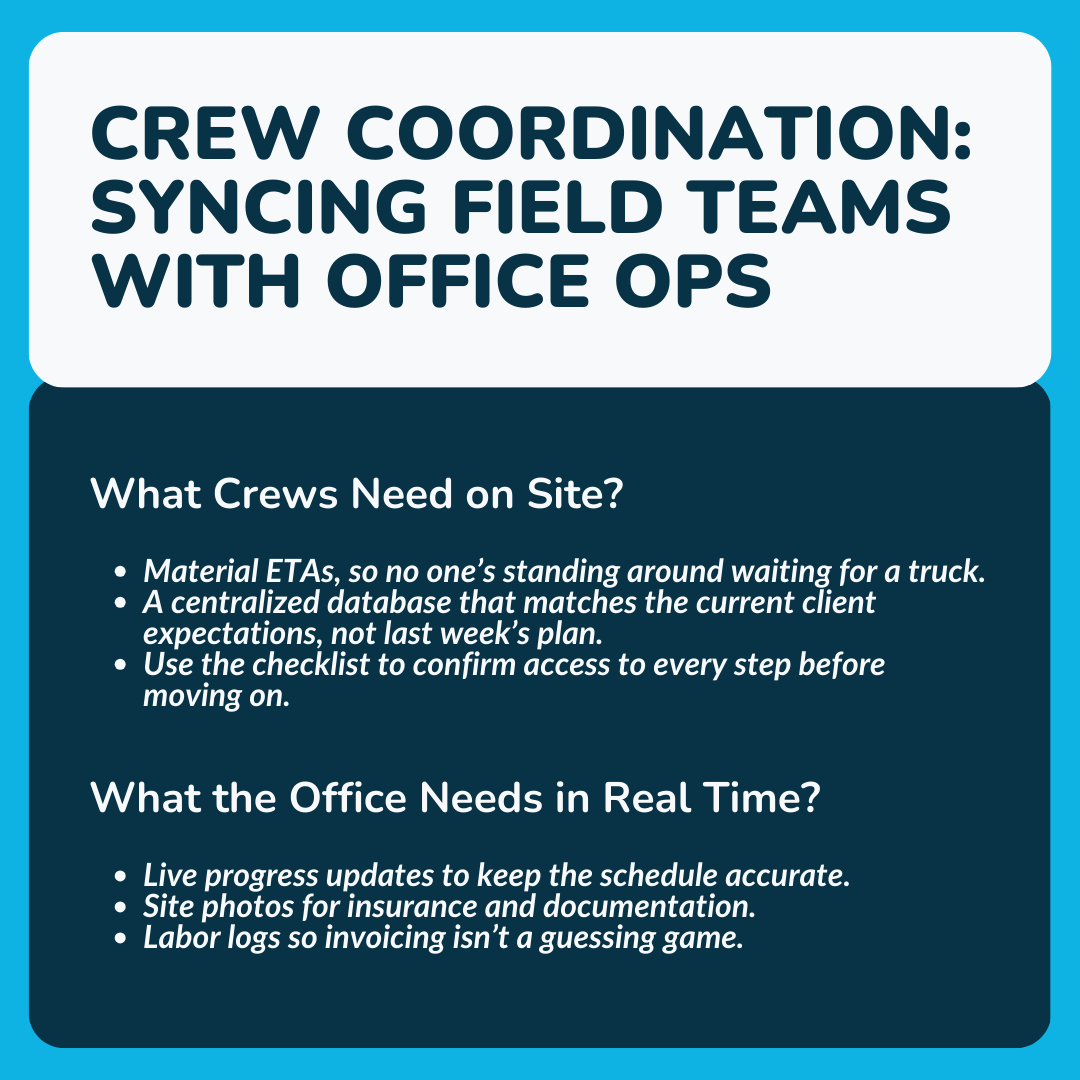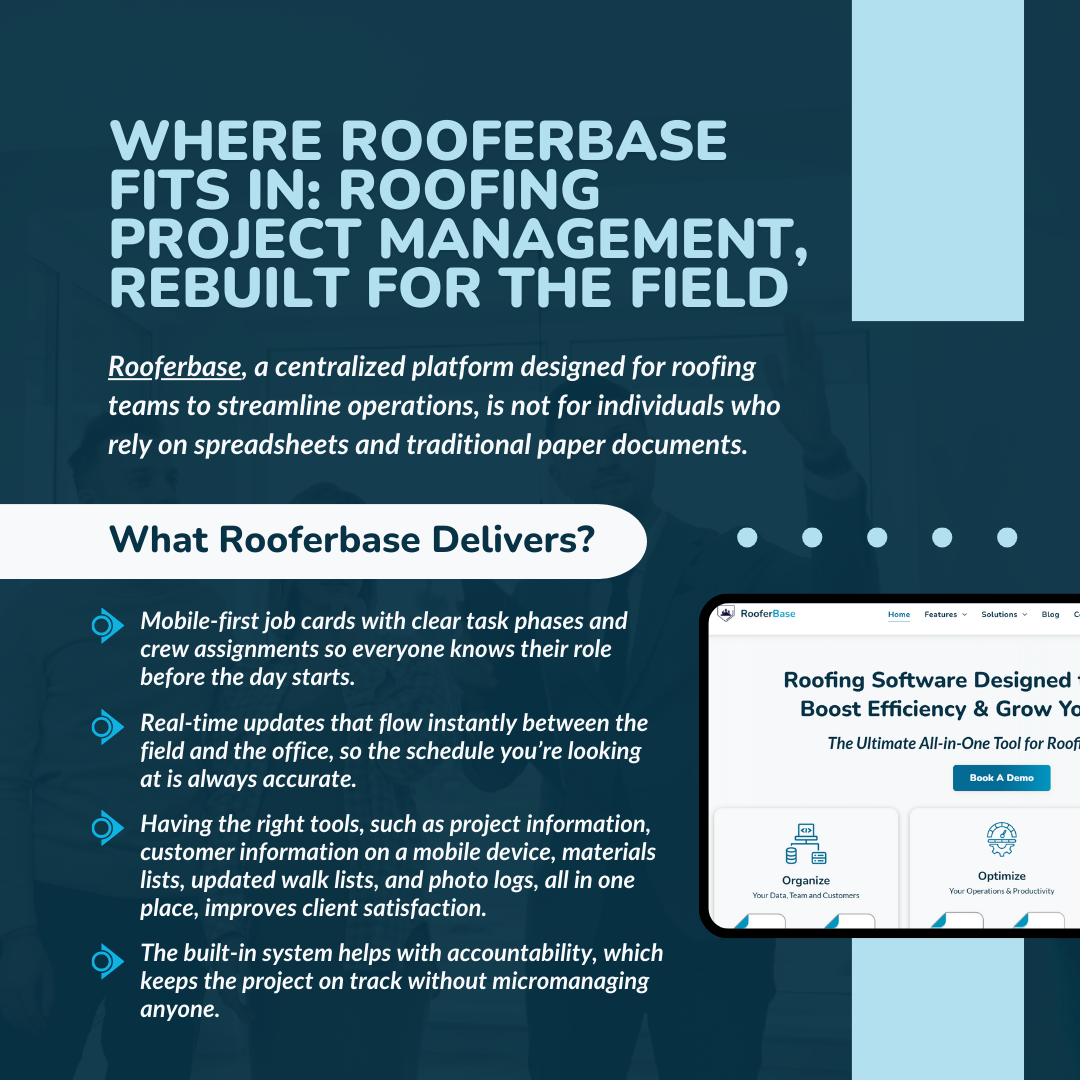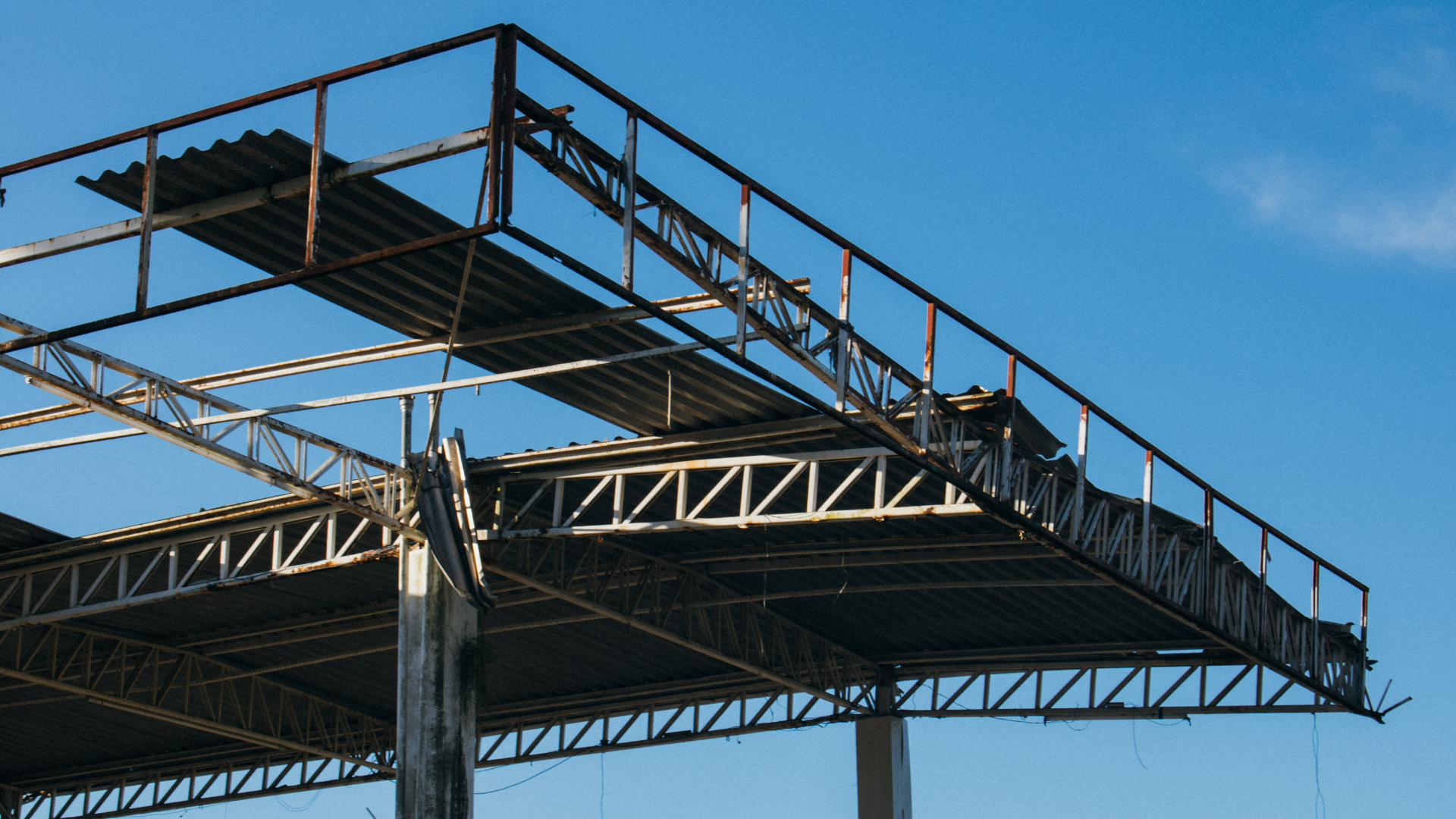September 12, 2025
Every roofing contractor knows the moment when a job starts to fall apart. For instance, the roofing project managers have arrived, but the roofing materials are still pending.
As a result, the roofing installation takes a long time, and tomorrow’s tear-off gets pushed. The homeowner starts calling, and the office is trying to determine workplace accidents on-site.
Roofing Project Management 101: How to Keep Every Job on Schedule
Disorganized roofing construction projects cost more than just time; they break the project's efficiency, delay payments, and damage client relationships.
Therefore, in this guide, we'll break down a proven field framework for keeping roofing jobs on track, from pre-install planning to final walkthrough.
You will be taught and shown how to ensure roofing contractors know when office work is completed and when to use roofing software, RooferBase, to eliminate scheduling hurdles, keep clients happy, and track your team's availability.
Quick Insights:
- Most rework is just avoidable misses; the right system finds them before they cost you.
- Generic project tools don’t fit the pace or workflow of roofing crews. Purpose-built software makes the difference.
- A clean project means: clear scope, scheduled drops, assigned crews, tracked progress, and documented completion.
- RooferBase isn’t another CRM. It’s a real-time execution system designed for roofs, not desktops.
What is Roofing Project Management?

Roofing project management involves the active coordination of labor and roofing managers, materials, timelines, inspections, project data, and project scope, all in real time.
It ensures that each job transitions smoothly from contract to completion without mishandling the entire project.
This is not about paperwork, but customer satisfaction and roofing project efficiency. It’s about keeping the job flowing from one stage to the next without delay and smoothing the overall project progress.
Why Roofing Businesses Demand a Different Approach?
Unlike general construction, roofing projects are often completed on compressed timelines. You’re not managing a single roofing business that is built over weeks.
You’re pushing multiple jobs across the calendar, often in the same neighborhood, with weather risk and homeowner pressure in. That changes the equation entirely.
Therefore, the roofing project management software ensures:
- Shorter job cycles that leave no room for mistakes
- Less tolerance for delay, because the next job is already scheduled
- Low risk, since one missed step can turn into rework, refund, or lost referral
- High volume across small crews that need real-time clarity
Where Most Teams Fall Apart?
Most roofing companies and owners either fail to plan their business operations carefully or rely on tools that were never designed for field operations.
In most cases, the critical details are scattered—spreadsheets live on office desktops, group chats pile up with missed messages, and project timelines exist only in the foreman’s head instead of the crew’s hands.
The result? Miscommunication, wasted time, frustrated homeowners, and jobs that spiral off schedule. This breaks down fast, especially when volume increases or teams grow.
Laying the Groundwork: Planning Before the First Shingle Lands
Bad planning or ineffective project management software can create problems before the first shingle ever hits the roof.
It’s not always chaos from the start. Sometimes it’s as small as ordering three squares too few or forgetting to assign a lead. But those minor misses don’t stay small; they multiply once the job begins.
Where Poor Planning Trips Up Roofing Projects
Without clear roofing management, it's hard to stay on the same page with your roofing installations, and you’ll see issues like:
- Incorrect material counts that create mid-job delays
- Misunderstood scope that leads to rework or missed line items
- No working timeline, which creates confusion between the office and the crew
These listed pain points are avoidable. They don’t come from bad crews; they come from a lack of careful planning.
Simple Planning That Cuts Job Stress
Most of the chaos you deal with on install day can be solved long before with careful and simple planning.
You don’t need frequent meetings. All you need is a roofing software that your team can run every time.
Key features of a centralized database:
- Confirm scope with site photos and contingency plans: Through this feature, you can capture and store visuals for clarity and prepare backup options to handle unexpected issues.
- Assign the crew their critical role: Make responsibilities visible so every team member knows their exact tasks before arriving on-site.
- Schedule and map material drops: You can avoid delays by ensuring materials arrive at the right place and time, with mapped delivery routes.
- Walk the site with your foreman: Document on-site inspections and updates in one shared system to keep both office and crew aligned.
- Use a digital checklist that the whole team can access: Standardize workflows, track progress, and avoid skipped steps.
Task Breakdown: Organizing the Workload for Speed and Accuracy

On a roofing job, the fastest way to lose a day is when everyone’s guessing what comes next.
Break the work into critical skills, give each step to the right person, and you’ll keep things moving without the “I thought you were doing that” moments with roofing business owners.
Key factors to look at:
1. Tear-Off
First things first, strip it clean. Work efficiently, put work where it's needed, protect landscaping, and ensure the driveway is free of nails before the homeowner returns.
2. Risk management
Before covering the roof, walk the deck thoroughly. If there’s wood or anything that’s going to cause problems in the future, inspect it now and get the work done.
3. Dry-In / Underlayment
Get the underlayment tight and sealed. There should be no wrinkles, no shortcuts. This is your shield against the weather, so if you rush it, you’ll regret it.
4. Shingle Layout + Install
Don’t just start slapping shingles. Snap your lines, check your pattern, and make sure it’s straight from the start. A crooked first row will haunt you forever.
5. Flashing and Venting
This is where you stop future leaks before they happen. Get the vents where they need to be, and make sure the roof can breathe.
6. Final Completion
The customer doesn’t notice the flashing you sweated over; they only notice if their yard is clean or a mess. So, sweep it, leave it cleaner than you found it. That’s what they’ll remember about your job.
Why This Works:
- When the team members know exactly who’s handling what, with photos and a quick pass/fail check before moving on, there’s no confusion.
- You’re not micromanaging, but with effective communication, you’re making sure the job’s buttoned up right, the first time.
Timeline Management: How to Keep Crews on Schedule?
In roofing, the clock can be your best friend or your biggest headache.
A delayed job doesn’t just waste a day—it disrupts the entire day; it pushes the rest of the week, making it harder to track progress, job site, or resource allocation.
The key? Stop relying on memory, whiteboards, or scattered office tools to run the schedule.
The Usual Roadblocks:
- Jobs take longer than planned, and suddenly, next week’s booked busy.
- No buffer for inspections, weather delays, or last-minute material runs.
- Delays reach the office only after the day has already gone off track.
How to Keep Things Moving?
1. Use a Visual Schedule Everyone Can See
No more “I didn’t know we were pushed back.” Give your crews a mobile-friendly tool through which they can track progress and streamline operations in real time.
2. Update info Right Away
If the schedule shifts, flag it right away—before hours are lost. Quick updates keep the whole team on track.
3. Build in Flex Time from the Start
Plan each job with buffer time for the inevitable: budget overrun, surprise repairs, an inspector who’s late, a storm that shows up early.
Read: What’s the Fastest Way to Measure Roof Dimensions in 2025?
Crew Coordination: Syncing Field Teams with Office Ops

A roofing job can be moving along perfectly until the field and office stop speaking the same language.
One missed update, and suddenly crews are waiting, the office is guessing, and the whole day starts to slip.
What Crews Need on Site
Crews on the ground need clarity at every step to keep work moving without interruption. That means:
- Material ETAs, so no one’s standing around waiting for deliveries.
- A centralized database that matches the current client expectations, not last week’s plan.
- A shared checklist that confirms site access, safety measures, and required steps before moving forward.
What the Office Needs in Real Time
The office side has its own critical needs to keep the bigger picture on track:
- Live progress updates to keep the schedule accurate and avoid surprises
- Site photos for insurance and documentation.
- Labor logs to ensure payroll, invoicing, and resource allocation aren’t left to guesswork.
When this data comes in instantly, office staff can adjust schedules, manage client expectations, and coordinate with suppliers before small issues turn into costly setbacks.
What Happens Without Project management software
- Steps are skipped because no one has seen the latest note.
- Crews overlap or duplicate each other’s work, creating chaos on-site
- Upsell opportunities vanish because no one had the correct info at the right time.
The result? Jobs drag out longer than expected, clients lose confidence, and profits shrink.
The Fix:
- When everyone’s looking at the same live updates or seamless operations, with efficient communication, work moves faster and cleaner.
- Another solution is to stop relying on text threads that get buried in group chats. Sync once with the centralized platform in the morning and stay aligned all day.
Industry Growth vs. Project Performance: The Roofing Reality Check
Let's examine key metrics data to understand the industry and its performance.
Where the Roofing Market Is Headed Through 2031:
| Category | Statistic | Detail |
|---|---|---|
| Market Size | $41 billion | Projected North American roofing market by 2031 |
| Growth Rate | 4.9% | Expected annual market growth |
| Workforce Size | 135,140 | U.S. roofing industry employees in 2023 |
| Workforce Growth | 6% | Expect employment growth by 2033 |
| Seasonal Demand | 41% | Homeowners planning roof projects during the 2024 storm season |
The Hard Truth About Roofing Project Performance:
| Category | Statistic | Details |
|---|---|---|
| On-Budget Delivery | 34% | Projects completed “mostly” or “always” on budget |
| Project Performance Rate | 73% | Average overall project performance rate |
| Full Benefit Realization | 36% | Projects achieving full intended benefits |
| Underperforming Projects | 70% | Projects failed |
Rework Prevention: Systems to Catch Mistakes Before They Happen
Rework is the silent profit killer in roofing. It’s not just the added cost of materials and labor; it’s the delays, the callbacks, the frustrated homeowners, and the extra strain on crews. Every mistake eats into margins and momentum.
The best fix? Catch issues before they ever leave the jobsite.
Where Rework Starts?
- Missed details like flashing, underlayment, or chimney prep.
- Incomplete cleanup that triggers call-backs and complaints.
- Scope creep without documentation can turn a quick job into a margin-eater.
A contingency plan:
- Tie every task to a clear punchlist with effective communication so nothing slips.
- Require photo documentation before a phase gets signed off.
- Add a final walkthrough to confirm the work is done on time before the team member leaves.
How RooferBase Makes It Automatic?
With RooferBase, quality checks aren’t optional—they’re built into the workflow.
- Team members upload site photos as they work.
- Punchlists live directly inside each job card.
- Phase completions trigger instant reviews by project managers.
It ensures that mistakes are caught the same day, saving time, dollars, and headaches while ensuring customers stay happy.
The Role of Technology in Roofing Project Management
The push to digitize roofing operations isn’t about chasing trends; it’s about keeping crews moving and jobs profitable.
The problem? Most project management tools were designed for office workers, not teams balancing on a roof. That’s why tools like Asana, Trello, or even Jobber can help track tasks, but fall short in the field.
Where Generic Tools Fall Short?
Roofing crews don’t sit behind screens; they’re working in mud, heat, or high winds. To keep projects moving, they need:
- Field-first design that works in mud, sun, and wind.
- Crew-level task views so everyone knows their role for the day.
- Offline mobile mode to keep updates flowing even when cell service cuts out.
What Roofing Teams Need?
A roofing project management tool should be built for how crews actually work. That means:
- Work in real time, even when the office is miles away.
- Skip the desktop logins and run entirely on mobile-first access with no clunky desktop logins.
- Keep tasks, timelines, and visual proof in one connected space.
Where RooferBase Fits In: Roofing Project Management, Rebuilt for the Field

RooferBase is a centralized platform designed for roofing teams to streamline operations. It’s not for those still juggling spreadsheets and paper forms.
Every feature is made to keep work moving smoothly without slowing anyone down.
What RooferBase Replaces?
- Endless text threads that get lost in the mix.
- Paper documents that never make it to the job site.
- Updates that arrive too late to make a difference.
What RooferBase Delivers?
- Mobile-first job cards: With clear task phases and crew assignments, everyone knows their role before the day starts.
- Real-time updates: Facilitates instant flow between the field and the office, so the schedule you’re looking at is always accurate.
- Material Usage Tracking: Keep track of material consumption per project, helping to manage inventory and reduce waste.
- Photo & Document Uploads: Allow crews to upload photos and documents directly to the platform, providing real-time visual updates and facilitating documentation.
- Customizable Reporting & Analytics: Access detailed reports on job costs, crew performance, and project timelines to make data-driven decisions and improve efficiency.
- Drag-and-Drop Job Scheduling: Easily assign and track jobs using an intuitive visual interface, allowing for quick adjustments and efficient resource allocation.
Final Punch List: Non-Negotiables for Effective Project Management Tools
A roofing project only runs clean when the essentials are nailed down. Here’s what that looks like:
- Scope confirmed with photos, so everyone’s working from the same plan.
- Material drop has been booked and confirmed before the crew arrives.
- Crews are lined up for each phase, ensuring work flows without bottlenecks.
- Task lists that can be checked off in real time, showing real progress—not guesses.
- A live schedule and status view ensure that the office and field see the same information.
- Post-job photo log and punch list review to ensure the job is closed without any loose ends.
Skip one of these, and you open the door to delays, missed details, and extra costs.
Conclusion: Roofing Project Management is a Field Discipline
Winning at roofing isn’t about “winging it better.” Mistakes like budget overruns, delayed schedules, and rework are choices, and so is lost profit.
The difference between a chaotic job and a smooth, profitable project lies in planning, communication, and real-time execution.
When every project is easily accessible, every task is tracked, and updates flow seamlessly between the field and office, results stop being unpredictable and start becoming repeatable. That’s where true growth lives.
And to achieve it, platforms like RooferBase come into play. By consolidating schedules, checklists, photos, and reporting in one mobile-first platform, RooferBase transforms how roofing teams operate, saving time, reducing stress, and protecting profit margins.
Tired of jobs slipping off track, crews chasing updates, and the office hunting down photos?
RooferBase is built for the pace you work at, fast crews, tight timelines, and the kind of chaos that happens on real roofs.
Book a demo and see how your next job runs when every detail falls into place.
FAQs
Q.1 What does a project manager do?
A roofing project manager supervises the lifecycle of a roofing project. Each project manager is responsible for and handles everything related to crews, timing, quality, materials, and communicating with the client in a timely fashion.
Q.2 State the stages of project management.
The five stages in project management include: Initiate or establish the objectives, make a plan, and execute it. After executing it, monitor the plan and, if needed, take corrective actions and close after it is executed.
Q.3 How do I market my roofing company?
Here are the ways you can market your roofing company:
- Start a referral program.
- Create a short sales pitch to use when canvassing neighborhoods.
- Attend industry and non-industry events.
- Build a company website
- Establish a strong social media presence.
Q.4 Which is the best project management software?
Roofing projects have their own requirements and needs. It depends on project size and company size, plus their worker ratio, etc. But there are many software programs like RooferBase that are best suited for roofing project managers.






